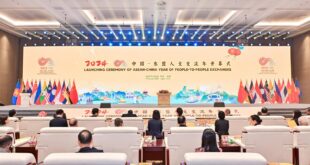A surge in China investment in infrastructure and energy is expected after Party General Secretary and President Xi Jinping’s recent visit to Hanoi, analysts say.
Vietnamese and Chinese government agencies have signed 36 cooperation agreements across multiple fields. Additionally, the two countries have signed a joint statement, emphasizing the deepening of the Comprehensive Strategic Cooperative Partnership and agreed to build a Vietnam-China community for future sharing with strategic importance.
Nguyen Khac Giang, a visiting researcher at the Yusof Ishak Institute in Singapore, said one of the main priorities for both sides is economic cooperation, especially in infrastructure connectivity, energy and the digital economy.
Infrastructure investment opens up many opportunities for both countries.
Recent reports by the World Bank and the International Monetary Fund indicate that one of the biggest challenges for Vietnam in the medium and long terms is the lack of funding for infrastructure, especially for transportation, logistics and green energy.
China on the other hand has deep pockets and leads in technologies in these areas.
Giang said the two nations have some unresolved issues related to infrastructure development, including capital management, transparency, accountability, and contractor selection.
But there have been some positive signs in investment cooperation between them, with Vietnam outlining the areas it needs investment in at the recent “Belt and Road” Forum and China making changes to its investment policies.
From large projects worth billions of U.S. dollars the country has shifted its focus to smaller ones with a greater potential for recouping investment.
“These moves lay the stepping stones that bring the two countries closer together to find a common voice,” Giang said.
“Medium-sized projects will help reduce [fears] about debt traps and increasing public debt.”
Chinese capital would also help Vietnam achieve its Net Zero commitment by 2050, a huge goal that requires large investments, he pointed out.
The two countries have agreed on a standard-gauge railroad line across their border and to study the possibility of a standard-gauge railway from the northern border province of Lao Cai to Hanoi and the port city of Hai Phong.
Two other lines included in the agreements are between Dong Dang in the border province of Ha Giang and the Vietnamese capital Hanoi, and the Mong Cai – Ha Long – Hai Phong route.
The leaders of the two countries also called on Vietnamese and Chinese businesses to collaborate on infrastructure like roads, bridges and rail routes, clean energy, telecommunications, and logistics.
Nguyen Vinh Quang, former director of the Central Foreign Affairs Committee’s China – Northeast Asia Department, said Vietnam could learn from the experience of other countries in managing Chinese capital.
More Chinese investment
Foreign direct investment from China is set to grow in the next two years, Nguyen Mai, chairman of the Association of Foreign Invested Enterprises, said.
“China invests hundreds of billions of dollars abroad every year, but only a small amount of that comes to Vietnam.”
But businesses in the two countries now seem ready to collaborate in high-tech fields instead of just labor-intensive industries such as textile and garment and footwear like before.
Before Xi’s visit large Chinese enterprises studied the possibility of investing in northern Vietnam.
Wingtech Group, China’s largest smartphone assembler, is considering Phu Tho Province, electronics manufacturer Goertek Group recently invested in a US$280 million project in northern Vietnam and expanded its existing one in the region.
“China’s changes dovetail with Vietnam’s transformation from labor-intensive to high-tech industries,” Mai said.
Some Chinese companies have admittedly created a bad impression but many others eye long-term investment opportunities in Vietnam, he added.
As of October China was the sixth biggest foreign investor in Vietnam with a total of $26.5 billion.
More trade
Trade is also expected to rise as China has promised to import more Vietnamese fruits such as watermelon and coconut.
It has also said it will create favorable conditions for Vietnamese exports of beef, pork and other livestock and poultry products.
Vietnam will increase sturgeon imports from China.
The two countries agreed to expand bilateral trade but in a more balanced and sustainable manner.
So it seems likely that their trade gap might gradually narrow. Vietnam’s deficit with China increased to a record $60.2 billion last year, a five-fold jump from 2008.
Vietnamese companies will see growing opportunities to access a billion-strong market.
Ngo Xuan Nam, deputy director of the Sanitary and Phytosanitary Notification Authority, said China is a large market with huge demand for agricultural and food products, especially tropical fruits and vegetables.
Data from his agency shows that exports of agricultural, forestry and fishery products to China jumped from $8 billion in 2015 to $14 billion in 2022. In the first eight months of 2023 they were worth $9.3 billion, a 3.2% rise year-on-year.
China supplies tens of billions of dollars worth of feedstock and intermediate goods Vietnamese manufacturers require.
“Vietnam’s manufacturing industry has close links with China. Without [it], Vietnam will have great difficulty rising in the global supply chain,” Giang said.
Vietnam’s exports of garments — for which 70% of raw materials are imported from China — and electronics were greatly affected when China closed its borders during the Covid-19 outbreak.
“The world is interconnected, and so no country can do everything without support from other countries,” Quang said.
But increased partnership does not benefit only Vietnam, he said.
“Vietnam’s geographical position plays an important role in China’s geostrategy, and China always recognizes this.”
Vietnam has a unique geographical location, is an important bridge connecting China with Southeast Asia and is an important country in the Belt and Road Initiative between China and ASEAN.
Vietnam also has a free trade agreement with the E.U. and is a member of the Comprehensive and Progressive Agreement for Trans-Pacific Partnership, which China wants to join.
In September Vietnam and the U.S. upgraded their relationship to a Comprehensive Strategic Partnership.
“Vietnam is like a gateway for China to reach out to other countries in the context of the superpower competition,” Giang added.
- Reduce Hair Loss with PURA D’OR Gold Label Shampoo
- Castor Oil Has Made a “Huge” Difference With Hair and Brow Growth
- Excessive hair loss in men: Signs of illness that cannot be subjective
- Dịch Vụ SEO Website ở Los Angeles, CA: đưa trang web doanh nghiệp bạn lên top Google
- Nails Salon Sierra Madre
 VnExpress News The News Gateway of Vietnam
VnExpress News The News Gateway of Vietnam




